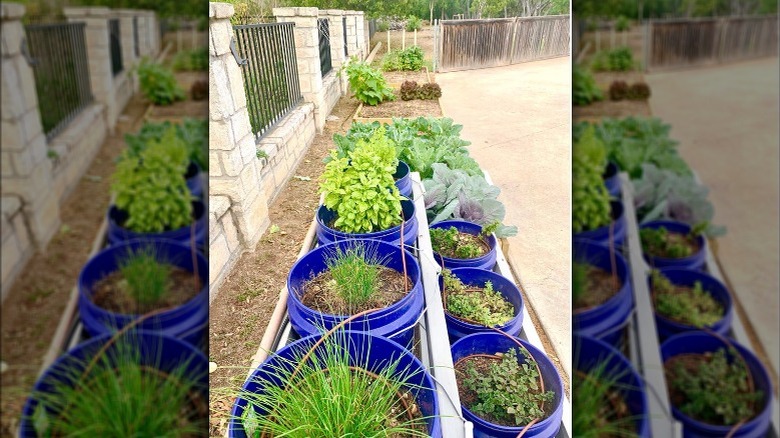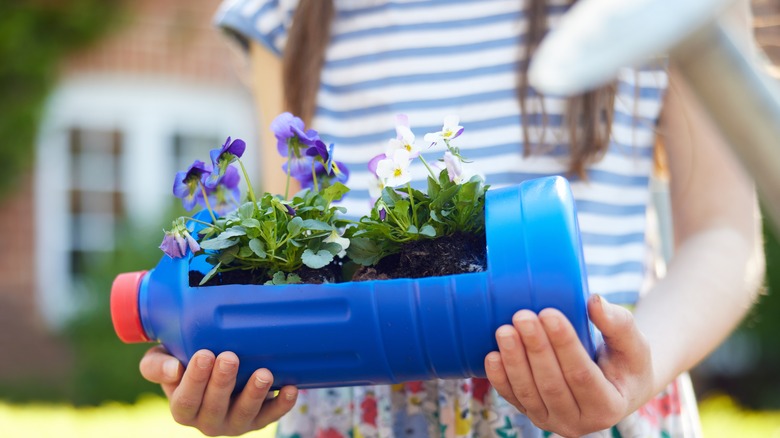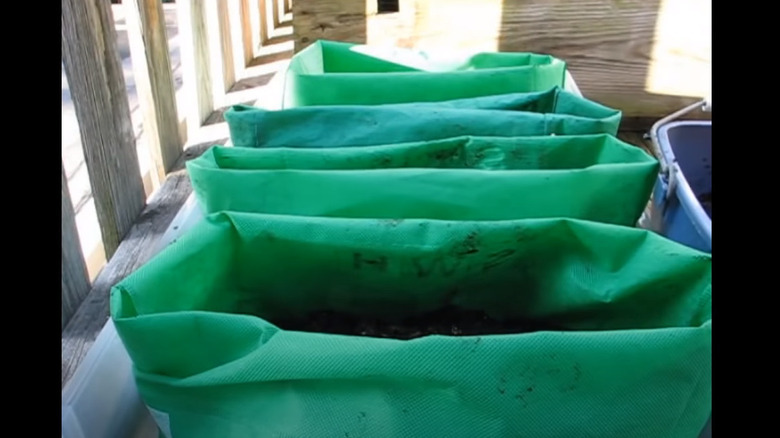Cheap Garden Containers You Likely Already Have Around The House
As the cost of food rises, it makes sense to try to grow some of your own produce, but when you start looking at supplies and tools, you discover those can be pricey, too. Thankfully, there's no rule that says you must use containers specifically made for plants. Your peppers will not care if they are grown in a hand-crafted raised bed or a kiddie pool — what they really need is enough sun, water, and nutrients to thrive.
Of course, there are a few standards your cheap containers must meet for your garden to be safe and successful. The first and most important rule to follow is you should never grow edible plants in an item that contains any kind of potentially toxic chemicals, like cleaning supplies, paint, or any kind of solvents. Secondly, you will need to select a planter to which you can add drainage. Soggy soil leads to root rot, and that leads to dead plants. This probably goes without saying, but we'll say it anyway: Your container must be sturdy enough to last at least one growing season, so no paper or anything fragile. With those standards in mind, here are some items you might already have around the house suitable for growing a cheap container garden.
Five-gallon buckets
Standard 5-gallon buckets have so many uses around the home and garden. They are great for hauling mulch, providing a makeshift stool, or cleaning up sticks around the yard. If you have accumulated a collection of these buckets, they also happen to make excellent planters. Standard 5-gallon buckets are almost 15 inches deep, so they can provide enough room for plant roots, including almost anything from carrots to determinate tomato plants, which only reach a limited height.
Since these buckets are about 12 inches across, this is the measurement you'll use to determine plant spacing. For example, you couldn't fit more than one tomato plant in 1 square foot of space, so that's all you should try to grow in one bucket. To get the most food from your planter, think vertically. Since cucumbers and pole beans should be planted about 4 inches apart, you can fit several plants in one container if you provide a trellis. Before filling your bucket with soil, drill several holes in the bottom about 8 inches apart to provide drainage.
Plastic kiddie pools
Have your children outgrown their plastic kiddie pool? Keep it out of the landfill while growing some food by using it as a planter! The great thing about this option is that you can even use damaged pools that are cracked on the bottom since you need drainage, anyway. So, if your kiddos got a little wild with the plastic pool last year, you might still be able to put it to good use. You don't even need kids to turn one of these items into a planter. They're only about $12 from Lowe's, which isn't bad, considering the standard size is 45 inches in diameter.
The challenge with this option is that these pools are not very deep, so they are only suitable for shallow-rooted plants that do not require staking. At less than 8 inches deep, carrots and rutabagas are not going to be an option for planting, but there are plenty of yummy options you can grow in a kiddie pool. Radishes, bush beans, and most types of leafy greens, including lettuce, have shallow root systems. If you want a small herb garden outside your kitchen door, parsley, dill, chives, and cilantro would do very well with this depth of soil. You could even grow garlic or onions in a kiddie pool. Like all the plastic options on this list, you'll need to drill drainage holes before planting.
Mineral tubs
You might not have these hanging around unless you farm livestock, but if you do purchase these products, you probably have a lot of leftover tubs! Farmers buy mineral tubs because the food source they contain provides vital minerals and nutrients to help keep the herd healthy. When the edible product has been consumed, what remains is a large container just waiting for an upcycle.
Mineral tubs are usually around 25 gallons, so they are quite large, and if you're lucky enough to know a farmer, you might be able to get some for free. You may also find them for sale online for a few bucks each. Since these containers must be sturdy enough to hold up to 125 pounds of edible products for livestock, they are certainly strong enough to handle some soil and plants. Because they are quite large, you could make the most of the space and plant some groupings with one tall plant, a smaller plant, and a vine. For example, you could fit a determinate tomato plant, vining winter squash, and marigold plant in one container — functional and pretty!
Food containers
For small, single plants, take a good look at your recycling bin. Coffee tubs, protein shake containers, or even milk jugs with the tops cut off can be used to grow food. The benefit of using these smaller containers is that they are easy to move and fit well in tight spaces like patio gardens. Like the kiddie pool planter, you cannot grow anything with an extensive root system, but growing some lettuce and herbs is certainly better than growing nothing.
These small food containers are also a fun way to do some experimenting to see what you can grow in a tight space. You can probably grow at least one prolific bush bean in a milk jug, and if you have a couple of plants in a couple of jugs, you could have enough green beans for a side dish every week or so. Using just a few food containers, you can have lettuce for those glorious summer BLTs, fresh dill for your potato salad, and even some cucumbers for fresh snacking.
Reusable plastic shopping bags
You can purchase grow bags, which make excellent low-cost planters, or you can dive into your extensive stash of reusable plastic shopping bags that just seem to accumulate from everywhere. We're not talking about plastic sacks but the sturdier reusable options. Now, we don't want you to stop taking some of your reusable shopping bags to the grocery store to keep those disposable sacks out of the landfill, but do you really need 85 shopping bags in your coat closet? Declutter and grow some food at the same time by turning some of them into planters.
Prepare your bags for planting by cutting several 1-inch holes in the bottom for drainage. Then add a couple of inches of rocks or something similarly heavy to keep the bag from blowing over. Fill the rest to the top with your soil mix. It's best to avoid anything very top-heavy in bags since they may fall over more easily than some of the other options on this list, but potatoes and leafy greens make excellent choices for growing in bags.





